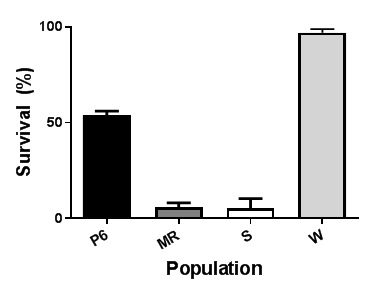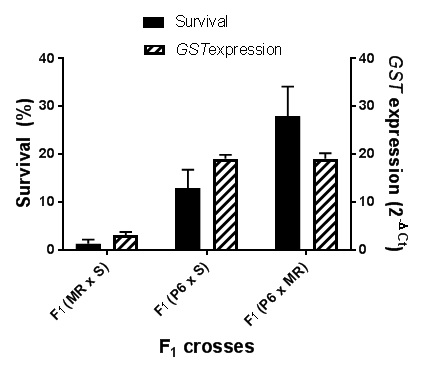Managing metabolic resistance in ryegrass with the existing pre emergence chemistries
Author: Roberto Busi and Stephen Powles (Australian Herbicide Resistance Initiative, School of Agriculture and Environment, The University of Western Australia, Perth, WA 6009, Australia). | Date: 14 Feb 2017
ɸExtra technical comment by Protech Consulting Pty Ltd
Take home messages
- Sakura® resistance can evolve in ryegrass.
- Two ryegrass populations show cross resistance between Sakura® and Boxer Gold®.
- An organo phosphate insecticide can reverse trifluralin resistance.
Background
In Australian agriculture weeds are the current greatest pest for grain growers. Geographical distribution and cost of control indicate that ryegrass is the most damaging weed affecting growers’ decisions and management in the Australian agricultural system (Llewellyn et al., 2016). Ryegrass is extremely adaptable and it can escape control because of its ability to evolve multiple resistance to herbicides.Research on multiple-resistant ryegrass reveal that metabolic resistance extends to commonly used herbicides and potential future discoveries. Research showed that phenotypic pyroxasulfone resistance (Sakura group K) can be selected in ryegrass by low dose recurrent selection. Pyroxasulfone selection has led to cross resistance to other important pre-emergent herbicides such as prosulfocarb and triallate. Another study showed that in randomly collected ryegrass field populations the selection with either prosulfocarb or pyroxasulfone can result in concomitant evolution of resistance to both prosulfocarb and pyroxasulfone after three generations.
A recent paper shows that the organo phosphate (OP) insecticide phorate can synergise with three different herbicide modes of action, enhancing the activity of the acetolactate synthase (ALS) inhibitor chlorsulfuron (60% resistance reduction), pyroxasulfone(45% resistance reduction) and trifluralin (70% resistance reduction) (Busi et al., 2017). Conversely, phorate antagonised the two thiocarbamate herbicides prosulfocarb and triallate. These studies have provided insight into the resistance mechanisms of pyroxasulfone resistance that appear mediated by greater metabolic activity through a glutathione conjugation pathway involving over-expression of putative resistance-endowing glutathione S-transferases (GST) genes. Results show a gradient and positive correlation between the quantified expression levels of GST in susceptible and resistant parental plants and the level of phenotypic resistance to pyroxasulfone in F1 progenies obtained via pair crosses of those assayed individuals.
Among the complexities of metabolic herbicide detoxification a greater knowledge of the resistance mechanism(s) may lead to an improved management of herbicide resistance in the major weed — ryegrass. The definition of the genetic basis of metabolic resistance in weeds can be a first crucial step towards chemical means to reverse resistance and improve long-term weed resistance management.

Figure 1. Survival (%) ± SE (n = 2) in pot cultured plants assessed 15 days after 100 g pyroxasulfone per ha. P6 is the Sakura® (pyroxasulfone) resistant ryegrass population selected six times with Sakura® and displaying resistance, MR is the parental ryegrass not resistant to Sakura®, S is the herbicide susceptible reference population and W is wheat.

Figure 2. Correlation between survival to pyroxasulfone in the F1 progeny and GST expression in parent ryegrass plants. Mean plant survival (black bars) of three types of F1 families (MR x S; P6 x S and P6 x MR) and sum of GST-1 and GST-2 expression (striped bars) to understand the correlation between the sum of GST expression levels of parental plants and plant survival observed in a total of 18 F1 families. Mean values ± SE are presented (n = 6 as the sum of three parent maternal and three paternal plants, respectively).
Conclusion
Diversity in herbicide use such as using herbicide mixtures (eg trifluralin and pyroxasulfone, trifluralin and prosulfocarb, or prosulfocarb and pyroxasulfoneɸ) or herbicide-insecticide mixtures is very important as it can increase the efficacy of ryegrass control and possibly delay resistance evolution.
ɸSakura (a.i. pyroxasulfon) label does not mention combining it with or being compatible with prosulfocarb and Boxer Gold (a.i. prosulfocarb) label does not mention combining it with or being compatible with proxasulfone. However the suggestion is feasible because labels do not state chemistries are incompatible.
Phorate is acting as a selective synergist in overcoming metabolic resistance in the weed ryegrass without compromising crop selectivity of the herbicide in wheat, yet. Further work is warranted to assess the efficacy against field-evolved trifluralin-resistant populations. We suggest that phorate could serve as a lead compound in a chemical synthesis program aimed to produce commercial, crop-selective herbicide synergists to overcome metabolic resistance.
Sakura® resistance appears to be metabolic and mediated by GST genes. There is great complexity in understanding metabolic herbicide detoxification and weed resistance. Thus, a greater knowledge of the resistance mechanism(s) may lead to an improved management of herbicide resistance in the major weed ryegrass. The definition of the genetic basis of metabolic resistance in weeds can be a first crucial step towards chemical means to reverse resistance and improve long-term weed resistance management.
Useful resources
The University of Western Australia - Dr. Roberto Busi
References
Busi, R., Gaines, TA. and Powles, S. (2017). Phorate can reverse P450 metabolism-based herbicide resistance in Lolium rigidum. Pest Management Science 73 (2), 410-417.
Llewellyn, R et al. (2016). Impact of weed on Australian grain production (GRDC)
Acknowledgements
Research undertaken as part of this project is made possible by the significant contributions of growers through both trial cooperation and the support of the GRDC — the author would like to thank them for their continued support.
Contact details
Roberto Busi
35 Stirling Hwy Crawley 6009 WA
0415 185 553, 08 64881423
roberto.busi@uwa.edu.au
@robbert115
GRDC Project Code: UWA00171,
Was this page helpful?
YOUR FEEDBACK
